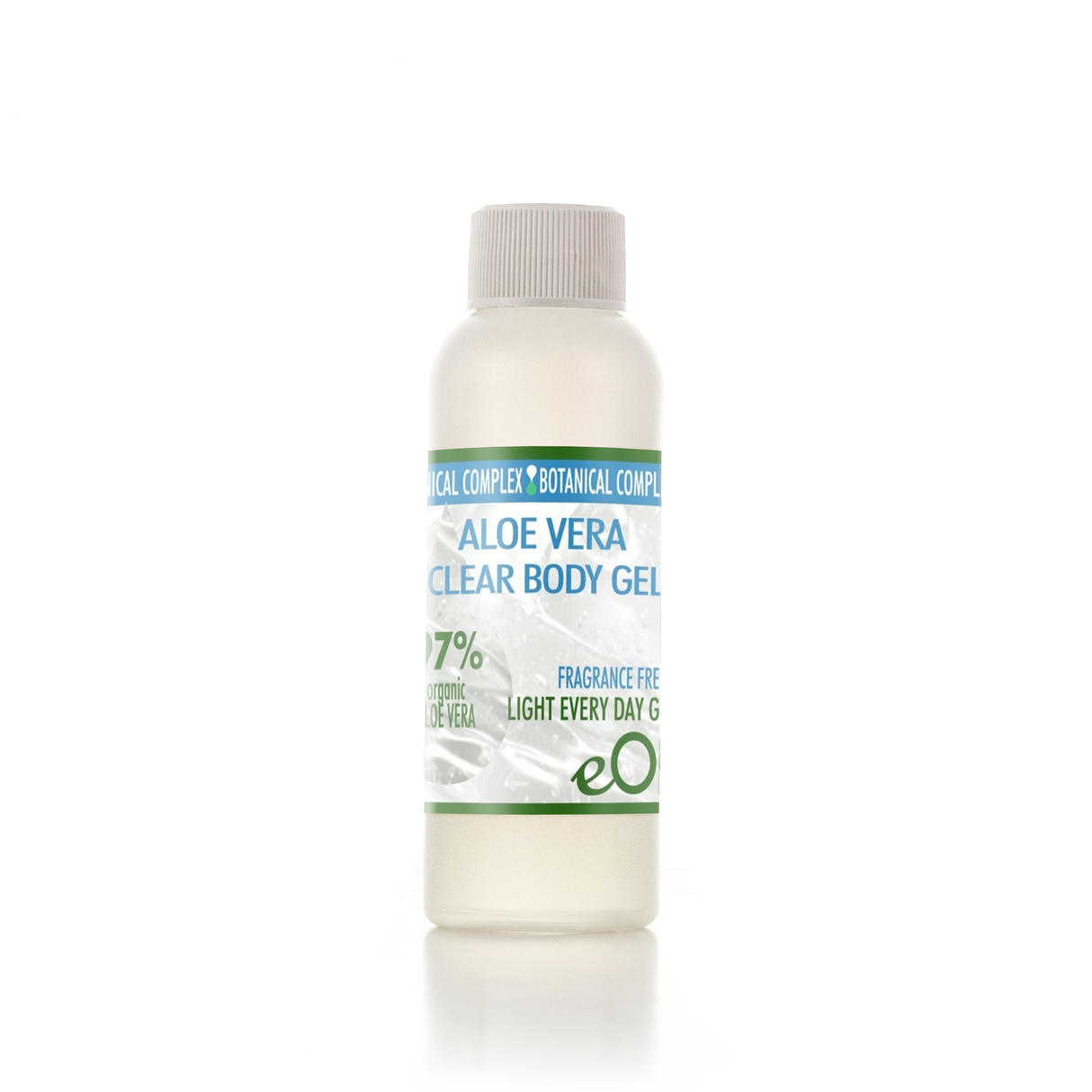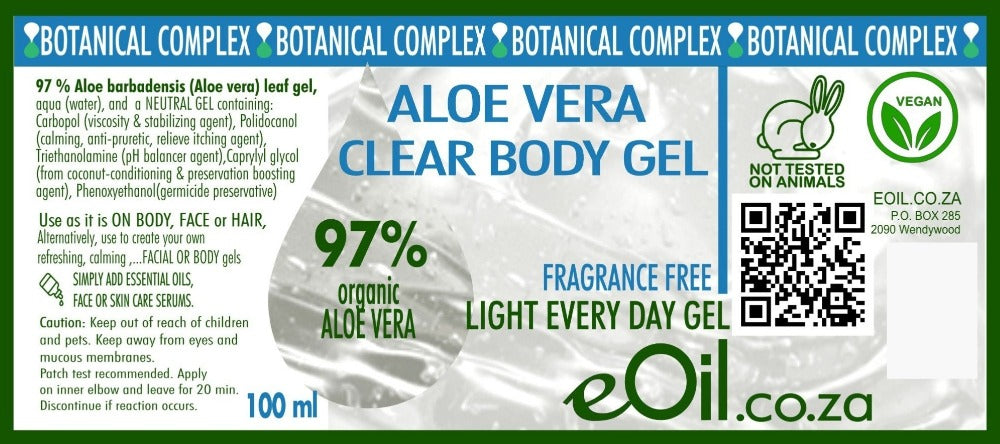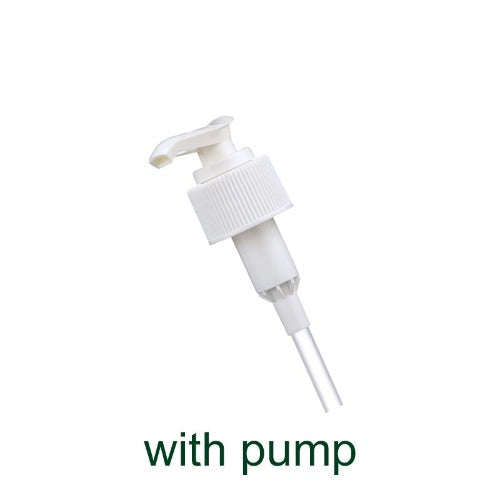Aloe Vera Clear Body Gel
Aloe Vera Clear Body Gel - 100 ml is backordered and will ship as soon as it is back in stock.
Description
Description
Aloe Vera Clear Body Gel - Aloe Barbadensis Miller
An Essential for Every Family's Skincare Needs:
Soothing After-Sun Care: An absolute must-have after a day in the sun. Apply generously to the face and body to instantly cool and soothe sun-exposed skin, helping to relieve the feeling of heat and tightness.
Lightweight Daily Moisturizer: Perfect for all skin types. Use it as a daily face and body moisturizer for a burst of non-greasy hydration that won't clog pores, especially in warmer weather.
Calming Skin Soother: Helps to calm the feeling of minor skin irritations and relieve the sensation of itchiness associated with dryness.
Refreshing After-Shave Gel: Its natural cooling properties make it an excellent, gentle gel to soothe and hydrate skin after shaving, helping to reduce the appearance of redness.
IDENTIFICATION
INCI name: Aloe Barbadensis Miller leaf distillate water
SKU code:
CAS number:94349-62-9
EXTRACTION METHOD: cold ultra-filtration
PART USED: inner leaf
ORIGIN: South Africa
COMMON NAME: Aloe vera original body gel-Fragrance free.
COLOUR: clear brown to amber red depending on seasons
PH: 6.5-7
QUALITY: Non-irradiated, GMO free, 100% organic Aloe vera hydrosol
PRESERVATIVES: potassium sorbate & sodium benzoate.
STORAGE CONDITIONS: store under cool (<21C), dry conditions. Use within 6 months of opening.
| HYDROSOL 1:10 | NORMAL 1:1 | CONCENTRATED 10:1 | ||
| LIQUID FORM | ||||
| HYDROSOL | HYDROSOL | |||
| CLEAR | CLEAR 1:1 | CLEAR 10:1 | ||
| NATURAL | NATURAL 1:1 | NATURAL 10:1 | ||
| GEL FORM 97 % | ||||
| CLEAR | CLEAR 1:1 | |||
| CONCENTRATED | NATURAL 10:1 |
Description
Aloe vera gel is the clear, jelly-like substance found in the inner part of the aloe plant leaf. It is extracted from the pulp of the leaves and has a high water content (98.5-99.5%). The gel is rich in polysaccharides, particularly acemannan, which is believed to be responsible for many of its therapeutic properties.
Composition
Aloe vera gel contains:
- Water (98.5-99.5%)
- Polysaccharides (acemannan, glucomannans)
- Amino acids
- Vitamins (A, C, E, B1, B2, B3, B6, B12, folic acid)
- Minerals (calcium, sodium, potassium, magnesium, chromium, zinc)
- Enzymes
- Lignin
- Saponins
- Salicylic acids
- Phytosterols
TRADITIONALLY USED FOR
Properties and Uses
Aloe vera gel is known for its:
- Wound healing properties
- Anti-inflammatory effects
- Moisturizing and hydrating effects
- Antioxidant activity
- Immunomodulatory effects
- Potential anti-diabetic properties
- Digestive health benefits
- Skin soothing properties
Common uses include:
- Topical application for skin conditions (burns, wounds, psoriasis)
- Oral consumption for digestive health
- Cosmetic ingredient in skincare and haircare products
- Potential diabetes management
- Oral health (mouthwashes)
Traditional Preparations
- Topical Application:
- Apply pure gel directly to skin for burns, cuts, or skin irritations
- Aloe Vera Drink:
- Mix 1-2 tablespoons of aloe vera gel with water or juice
- Face Mask:
- Combine aloe vera gel with honey or other natural ingredients for a soothing face mask
CAUTION
- May cause allergic reactions in some individuals
- Oral consumption may cause digestive discomfort in some people
- May lower blood sugar levels; monitor if diabetic
- Can interact with certain medications (e.g., diuretics, diabetes medications)
- Avoid use during pregnancy and breastfeeding without medical advice
- Ensure products are free from anthraquinones (laxative compounds found in aloe latex)
Absorption Enhancement Properties
Recent studies have shown that aloe vera gel can enhance the absorption of vitamins C and E when taken orally.
It may also improve the intestinal absorption of poorly absorbable drugs and enhance skin penetration of certain compounds.
Pharmaceutical Applications
Dried aloe vera gel has shown potential as an excipient in modified release matrix type tablets, demonstrating good swelling properties and sustained release behavior.
While aloe vera gel has a long history of traditional use and shows promise in various applications, more research is needed to fully establish its efficacy and safety for different health conditions.
Always consult with a healthcare professional before using aloe vera gel products, especially for internal use or medical purposes.

Aloe Vera Clear Body Gel - 100 ml is backordered and will ship as soon as it is back in stock.





